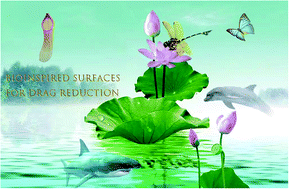Bioinspired surfaces with special micro-structures and wettability for drag reduction: which surface design will be a better choice?
Abstract
Human beings learn from creatures in nature and imitate them to solve challenges in daily life. Thus, the use of bioinspired surfaces for drag reduction has attracted extensive attention in recent years due to their important applications in many fields, such as pipeline systems, maritime transportation, and military weapons. Herein, we introduce some typical plants and animals with low drag surfaces that exist in nature, focusing on their drag reduction patterns. There are two main mechanisms to explain how surfaces reduce frictional drag, where one is to design a suitable surface geometry to change the flow distribution of surrounding fluid and the other is to introduce a low friction lubricating layer (usually air or non-toxic silicone oil) to partially or completely replace the solid–liquid interface. Hence, by mimicking these organisms, some surfaces have been fabricated to reduce frictional drag, including riblets, superhydrophobic surfaces, and slippery liquid-infused porous surfaces. With the increasing research on drag-reducing surfaces, the drag reduction rate of different types of surface designs has greatly improved in recent years. This review provides a holistic overview that facilitates direct comparisons between these surface types. To select an optimal surface for drag reduction in practical applications, the merits and deficiencies of different surface designs are analysed and compared. Finally, based on the current challenges, we present some future prospects for the application of bioinspired surfaces in drag reduction.

- This article is part of the themed collection: Recent Review Articles


 Please wait while we load your content...
Please wait while we load your content...